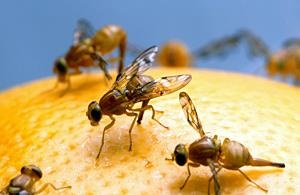Global pact against plant pests marks 60 years in action
3 April 2012, Rome - FAO today marked the 60th anniversary of the International Plant Protection Convention (IPPC), a treaty established in 1952 to help prevent plant pests and diseases from spreading across international boundaries via international trade.
The origins of the convention can be traced back to 1865, when a French wine merchant imported a case of American vines infected with an alien species of aphid that nearly wiped France's wine industry off the map.
Frightened Italian farmers ripped up kilometers of newly installed railroad tracks to prevent the invading pest from moving south.
Today, with the global trade in agriculture products booming like never before, plant pests and diseases remain a significant challenge for food production and security.
The problem: as people and agricultural products move from country to country and region to region, pests move with them — hidden on the undersides of leaves or in the cracks of shipping crates, for example.
Plant pests and diseases have a serious effect on food production — global crop yields are reduced by 20 to 40 percent per year due to to plant pests and diseases, estimates the FAO-based IPPC Secretariat.
For farmers anywhere, pests are a problem. But for small-scale growers in the developing world, drags on production or the loss of a crop can mean the difference between survival and starvation. For example, the larger grain borer ravaged Eastern Africa in the 1980s after being introduced from Central America, destroying up to 80 percent of stored grains and causing widespread localized food shortages.
An ounce of prevention...
FAO projects that the world will need to produce 60 percent more food to feed an expanded world population by 2050 -- crop production is expected to continue to account for 80 percent of the world's food. Reducing losses of food due to crop pests will therefore play an important part in meeting the world's food needs.
"In today's globalized era, the task of preventing plant pests and diseases from spreading while facilitating rather than impeding trade is both more complex and more important than ever," said FAO Director-General José Graziano da Silva, "especially since warmer temperatures due to climate change are expected to both encourage the spread of pests into new areas as well as render some plants more susceptible to their effects."
He added that preventing the introduction of new pests, including invasive plants, into a country is far more cost effective than trying to eradicate or manage an outbreak after-the-fact.
"Prevention also means we avoid overuse of chemical pesticides, reducing financial burdens on farmers and safeguarding the environment and productive ecosystems," Graziano da Silva noted.
According to the IPPC, global sales of pesticides for plant pest control run around $45 billion per year.
Shared standards, safe trade
One of the IPPC's main activities is to establish and promote the use of science-based, internationally-agreed standards governing how plants and plant products should be handled during international trade or their movement across international boundaries, known as International Standards for Phytosanitary Measures, or ISPMs.
ISPMs cover a range of issues, from how products or product packing materials must be treated prior to export to procedures and methodologies used by agricultural inspectors in importing nations.
The IPPC also acts as an information exchange hub, promoting information sharing and transparency in international pest management and allowing participating countries to stay on top of important export requirements. The status of agricultural pests and new developments in plant protection and risk management are also critical components.
Additionally, a new and growing focus for the Secretariat is providing developing countries with technical assistance to support their ability to implement the Convention and the ISPMs. This support often includes the Phytosanitary Capacity Evaluation, a low-cost, comprehensive evaluation of a country's phytosanitary system that can be used to focus on the most immediate phytosanitary development needs.
The Convention consists of 177 Member countries, each of which maintains a National Plant Protection Organization. A group of ten regional Plant Protection Organizations then provide a way for countries to operate jointly at the regional level to prevent plant pests from crossing borders. An FAO-based Secretariat provides overall coordination.
